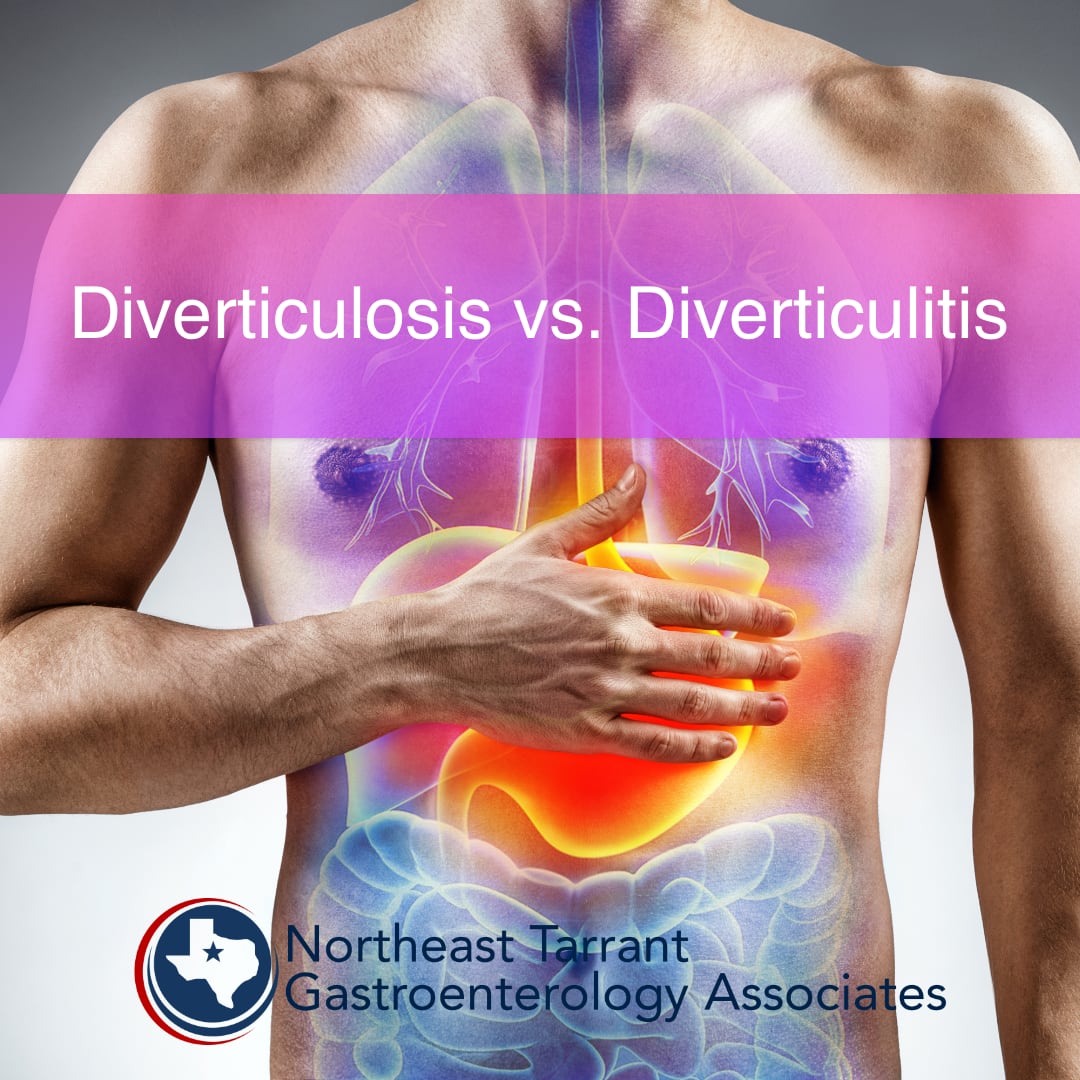Diverticulosis vs. Diverticulitis
 To help understand diverticulitis, it is important to understand what diverticula are, as well as what distinguishes diverticulitis from diverticulosis. Diverticula are small pockets (i.e. herniations) that develop along the walls of the digestive tract, most commonly in the large intestine. Merely having these small pockets is known as diverticulosis. In a small percentage of people with diverticulosis (roughly 5%), inflammation can develop in these pockets. This is what is known as diverticulitis.
To help understand diverticulitis, it is important to understand what diverticula are, as well as what distinguishes diverticulitis from diverticulosis. Diverticula are small pockets (i.e. herniations) that develop along the walls of the digestive tract, most commonly in the large intestine. Merely having these small pockets is known as diverticulosis. In a small percentage of people with diverticulosis (roughly 5%), inflammation can develop in these pockets. This is what is known as diverticulitis.
Causes
Diverticula typically develop at the “weak points” of the large intestine. Most frequently, this occurs on the left side of the colon (sigmoid and descending colon) where blood vessels dive in and out of the muscle layers. Although the exact mechanism by which these pockets form is unknown, it is postulated that increased pressures inside the colon cause these small herniations to develop (i.e. the colon generating excess pressure attempting to move stool through the colon during bouts of constipation).
Diverticulitis occurs when a diverticulum becomes inflamed or infected. This often occurs due to small tears in the tissue that comprise the diverticulum (remember, diverticula are herniations of normal tissue; so, the tissue that comprises the diverticula is thin and more prone to trauma).
Risk Factors
The development of diverticulosis is a relatively common phenomenon that occurs with aging. Slightly over 50 % of people will have evidence of diverticulosis by age 60 and the percentage continues to increase with advancing aging. Likewise, advanced age is also a risk factor for the subsequent development of diverticulitis. Along with aging, other common risk factors for diverticulitis include:
- Advanced age
- Obesity
- Sedentary Lifestyle
- Smoking
- Low fiber/high animal fat diets
Symptoms
The mere presence of diverticulosis in the GI tract typically causes no symptoms. When these pockets become inflamed (diverticulitis), however, a wide array of symptoms can develop. These include:
- Persistent abdominal pain
- Altered bowel habits (constipation > diarrhea)
- Fever
- Nausea and vomiting
- Rectal bleeding
Potential Complications
On average, approximately 1 in 4 individuals with a flare of diverticulitis will experience a complication such as:
- Abscess formation (a “pus pocket” at the site of infection)
- Perforation and resultant peritonitis (rupturing of the diverticulum, resulting in leakage of fecal contents into the abdomen)
- Scarring/stricturing of the bowel resulting in a blockage of the intestines
- Fistula formation (an abnormal passage/tunnel between the intestines and another organ such as the bladder)
Diagnosis
Due to the fact that the symptoms of diverticulitis can mimic many other disease processes, a variety of tests may be employed during the course a patient’s evaluation. Some of the more common tests include:
- Bloodwork to evaluate for signs of infection
- Urinalysis to assess for UTIs and other genitourinary problems
- Stool studies if diarrhea is present
- Imaging studies such as a CT Scan
- Endoscopy (Colonoscopy and/or Upper Endoscopy)
Treatment
Treatment is typically dependent on the severity of the infection and whether or not complications are present
Uncomplicated Diverticulitis (mild symptoms): Home-based treatment with oral antibiotics and bowel rest (i.e. a liquid diet)
Complicated Diverticulitis (severe symptoms and/or presence of a previously listed complication): Hospitalization with IV antibiotics, pain control, anti-nausea medications, bowel rest and possibly a surgical evaluation depending on the severity of the symptoms
Prevention
Obviously, no one wants to suffer a bout of diverticulitis; thus, like many other conditions, prevention is the best strategy. Preventative measures include:
- High fiber diets: Fiber-rich foods help soften stool, decreasing the amount of pressure the colon needs to generate to move solid waste along. Less pressure = less strain and force on the “weak points” of the colon wall; thus, less opportunity for the development of diverticulosis and diverticulitis. For more on fiber, please follow the link to our recent blog post on the benefits of fiber and fiber-rich foods.
- As an aside, seeds, nuts, berries, cucumbers, popcorn, etc.... DO NOT increase your risk of developing diverticulitis. That is little more than an “old wives’ tale”
Drink plenty of fluids: Fiber keeps stool soft by absorbing water. As such, adequate daily fluid intake is essential. - Routine exercise: Exercise promotes normal bowel activity, reducing constipation
- Avoid smoking
We hope the above information has been helpful. If you have further questions or concerns, please feel free to schedule an appointment with us. We look forward to seeing you!
CALL TODAY 817-284-2693

 Meet Dr. Mark Murray
Meet Dr. Mark Murray Meet Dr. Eric M. Hill
Meet Dr. Eric M. Hill Meet Dr. kevin Ho
Meet Dr. kevin Ho